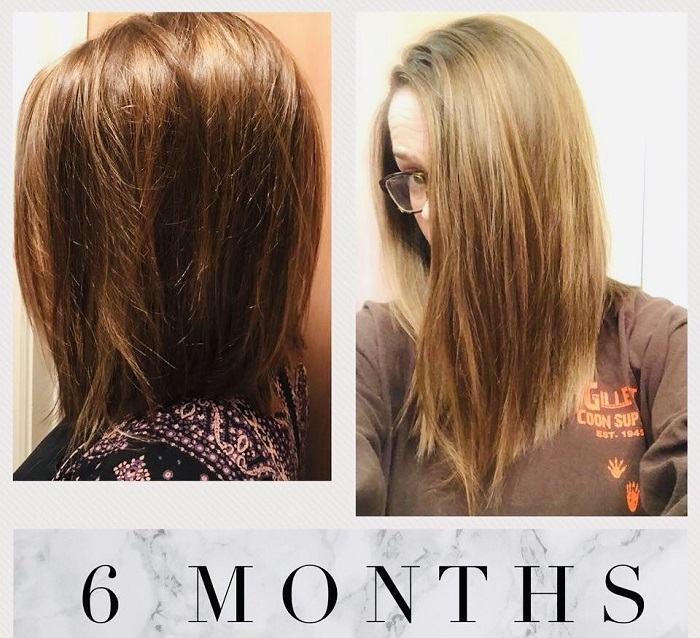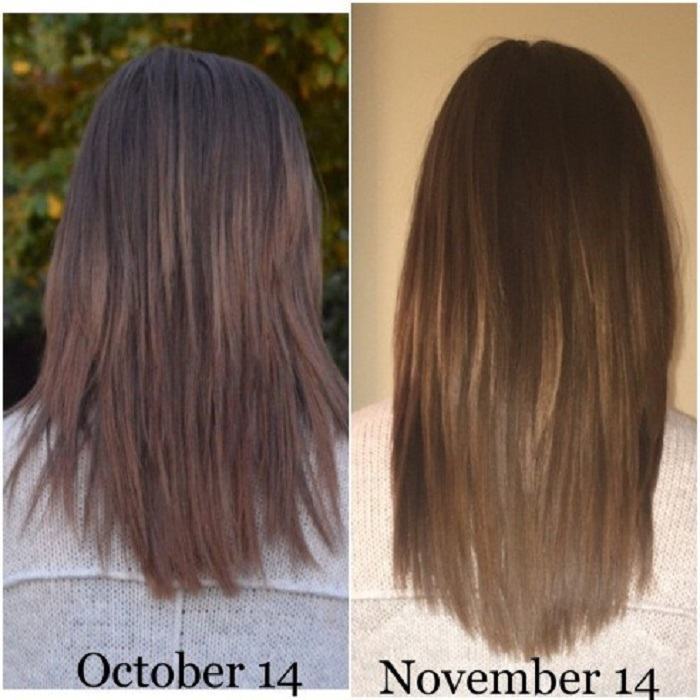Hair develops at a speed of around 1.25 centimeters (0.5 inch) every month, or around 15 centimetres (6 inches) each year. As indicated by Bridgette Hill, an authorized trichology and maker of Root Cause Scalp Analysis, hair grows approximately 14 to 12 inches each month overall. Obviously, this differs by individual, but on the off chance that your hair (and scalp) are solid, your hair ought to develop every month.
Contents
- How much does hair grow in a month?
- Hair improvement is affected by an assortment of variables.
- Below are the phases of hair growth.
- 1. Get a back massage and a scalp massage.
- 2. Inspect your cleaning routine.
- 3. Schedule a consultation with a trichologist.
- 4. Investigate various options for hair-growth supplements.
- 5. Think about hair supplements.
How much does hair grow in a month?
Sophia Porter, an expert hairdresser, works out the four vital periods of hair growth: Anagen, catagen, telogen, and exogen. “Where your hair creates the most extreme length is set up,” Porter adds. Anagen is the growth stage. This time of hair improvement might last somewhere in the range of two to seven years, contingent upon the person. The following stage is catagen, which is otherwise called the relapse and progress stage. Hair growth eases back and follicles recoil during this period, which lasts approximately seven to ten days.
Porter estimates that ten to fifteen percent of hairs on the scalp are in the telogen stage at any given time. Old hair is resting and new hair is being created at this phase of advancement. Finally, as the hair is lost from the follicle, it is called exogen. “An individual loses approximately 50 to 150 hairs consistently, by and large,” Porter clarifies. In this way, assuming you see a couple of strands in your hairbrush, don’t be concerned.

How much does hair grow in a month?
Relax, assuming this seems hard to appreciate. The most fundamental thing to recall is that hair growth, like all the other things in everyday life, is a cycle, and assuming your hair and body are sound, you should see growth (more on this below).
Hair improvement is affected by an assortment of variables.
Indeed, even while we as a whole realize that hair ought to develop at a consistent rate consistently, there are various justifications for why your growth might be eased back. Hair misfortune is polygenic, implying that it is brought about by a blend of qualities, Hill clarifies. “In any case, it very well may be set off by anything as straightforward as an unfavourably susceptible reaction to hair items.”
Slope guarantees that hereditary qualities and chemicals have the most impact on hair improvement, but there are different interesting points. Chemical changes may happen because of an ailment, pregnancy, or stress. Also, let’s face it, a few people are basically brought into the world with quickly developing hair (# blessed).
Obviously, your body’s overall wellbeing might have an effect. Hair growth might be impacted by persistent infections, fevers, and medications. There are other ways of life factors like pressure, as well as food and nutrient inadequacies, which all have a section on hair advancement. To hold hair growth at its best, it’s basic to eat an even eating routine and carry on with a solid way of life, Porter adds. The anagen, catagen, and telogen stages are the three phases of hair advancement. Each strand of hair on the human body is created at its own speed. At the point when the cycle is done, it is restarted, and another strand of hair is framed.
Below are the phases of hair growth.
Anagen Phase
Anagen is the dynamic growth time of hair follicles when the hair root separates rapidly and adds to the hair shaft. Hair develops about 1 centimetre at regular intervals during this period. Scalp hair stays in this dynamic period of advancement for 2–7 years, contingent upon hereditary qualities.
Catagen phase
The catagen stage is a short progress period that follows the anagen stage. It denotes the decision of a hair’s dynamic growth cycle. This stage goes on for around 2–3 weeks, during which time the hair changes into club hair. This methodology withdraws the hair from its blood supply just as the cells that create new hair.
Phases of telogen
The resting hair stays in the follicle during telogen until it is constrained out by the new anagen hair. The telogen stage happens when the hair follicle is very still. 10% to 15% of all hairs are in the telogen stage at any given second. For hairs on the scalp, this stage goes on for around 100 days, yet it endures for an extensive time for hairs on the eyebrow, eyelid, arm, and leg.
This month, there are five systems to assist your hair in developing.
“The most important methodology is to treat your body well,” Hill clarifies. Put resources into your health and wellness to give your scalp and hair a fighting chance.While there is no otherworldly medication or strategy that can cause your hair to become quicker or longer in a moment, here are some expert techniques to assist you with improving outcomes:
1. Get a back massage and a scalp massage.
A sound scalp is essential for great hair growth. Slope recommends using an oil-based scalp cover to treat your scalp’s current needs while likewise advancing cell turnover. For best outcomes, I suggest that my customers rest during their pre-scalp treatment, “Hill clarifies. Kneading the scalp may likewise assist with drawing in the scalp muscles and increasing blood flow. Truly, a little gathering of guys in a 2016 exploration got a day-by-day four-minute scalp rub. The specialists found an increment in hair thickness towards the end of the preliminary. In a later 2019 examination, around 70% of the 300 or so people who followed a specific back rub programme detailed expanded hair thickness at the finish of the preliminary.
2. Inspect your cleaning routine.
Let’s get straight to the point: scalp purging is an outright should. And no, dry cleanser won’t cut it. As per Hill, “executing an intensive washing routine is a distinct advantage for the scalp and hair misfortune.” However, utilising a cleanser to clean the scalp and hair isn’t always vital. “A gentle cleaning might be just about as basic as flushing under the showerhead, and apple juice-based washes and co-washes are a staggering choice.”
3. Schedule a consultation with a trichologist.
Think about booking an encounter with a nearby trichologist to look into the overall wellbeing of your hair and scalp. You might have your blood board checked by an in-trichologist for scalp and hair, as per Hill, who will take a gander at your document through a “trichological” focal point. This may assist you with sorting out if there are any basic principal issues influencing your hair improvement.
4. Investigate various options for hair-growth supplements.
Assuming you’re contemplating whether hair care products that guarantee longer, more grounded, more quickly developing hair really work, the appropriate response is yes. Hair-growth medicines are principally androgen blockers with dynamic synthetic compounds that fool the body into delaying the hair cycle’s developing stage, “Hill clarifies. “These topicals and inner dietary enhancements have been demonstrated to work in clinical and logical examinations.” Even though they aren’t actually developing your hair, they are securing the hair follicle’s trustworthiness and assisting it to remain in the growth stage for longer.
5. Think about hair supplements.
Hair is comprised of the protein keratin, which contains cysteine, serine, glutamate corrosive, glycine, and proline among its amino acids. A considerable lot of these amino acids are plentiful in both collagen and biotin supplements, suggesting that the enhancements give the body the building blocks for hair. This is supported by research, which shows that taking these supplements supported hair advancement.
If your body, hair, and scalp are all in good condition, you should expect to grow 14 to 12 crawls of hair on a regular basis.A variety of factors may influence how much hair grows, but a simple visit to a trichologist can assist in identifying any fundamental issues that are preventing you from reaching your hair goals.

End
Caucasian hair develops at a speed of 0.3 mm each day, or 1 cm each month. African hair develops at a pace of 0.8 cm each month, though Asian hair develops at a pace of 1.5 cm each month. The way that the hair tumbles off at the ends gives the appearance of not creating hair. Tragically, the length of the hair remains relatively similar when it develops at the roots but separates at the ends.
Hair fills in a cycle that is unique to you. Hair might develop somewhere in the range of 1/2 inch to a full inch in a month during the anagen stage, contingent upon your hereditary qualities and different conditions. Hair develops at around 1/2 inch consistently, all things considered, as per the American Academy of Dermatology. The hair on your head develops at a pace of about 6 inches each year. Hair develops at around 1/2 inch consistently overall, as indicated by the American Academy of Dermatology. The hair on your head develops at a pace of about 6 inches each year. Your hair will develop at an alternate rate contingent upon your age.
